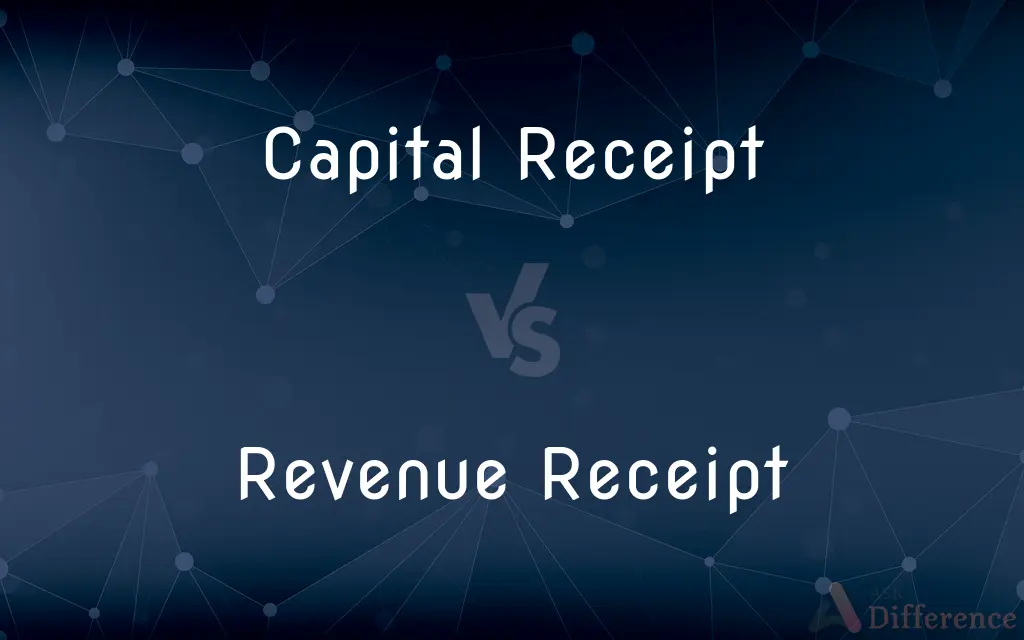Capital Receipt vs. Revenue Receipt — What's the Difference?
By Tayyaba Rehman — Published on October 25, 2023
Capital Receipts are funds received from non-operational sources, typically altering the financial structure, while Revenue Receipts are funds received from operational activities, maintaining business regularity without creating liabilities.

Difference Between Capital Receipt and Revenue Receipt
Table of Contents
ADVERTISEMENT
Key Differences
Capital Receipts refer to the funds received by a business or government from sources that are not related to their regular operational activities, usually involving financial adjustments like acquiring loans or selling assets. On the other hand, Revenue Receipts represent the funds received from the core operational activities, typically recurring and contributing to the ongoing sustainability of the entity, like sales revenue or service fees.
In terms of business operations, Capital Receipts are usually infrequent and can involve alterations to the financial structure of the entity, often implying a future obligation like repayment of a loan. In contrast, Revenue Receipts are recurring and regular, maintaining the operational regularity of the business, without creating liabilities or reducing assets.
Capital Receipts usually do not impact the Profit & Loss account as they are associated with the financing or investing activities of an entity, like proceeds from the sale of fixed assets or from issuing shares. Conversely, Revenue Receipts directly impact the Profit & Loss account since they are derived from the day-to-day operations of the business, contributing to the entity's net income or loss.
The treatment of Capital Receipts in financial statements is typically under balance sheet accounts, reflecting changes in the asset, liability, or equity sections. Revenue Receipts, however, are recorded in the income statement, portraying the entity's operational performance and contributing to the computation of net profit or loss.
In summary, Capital Receipts and Revenue Receipts are integral components of financial accounting, distinctly categorized based on their origin and impact on the financial statements. While Capital Receipts involve substantial alterations to the entity’s financial structure, usually from non-operational activities, Revenue Receipts ensure the ongoing operational sustainability, originating from the core business activities.
ADVERTISEMENT
Comparison Chart
Source
Non-operational activities like loans or sale of assets.
Operational activities like sales or service fees.
Impact on Financial Structure
Alters the financial structure, may create liabilities or reduce assets.
Maintains business regularity without creating liabilities or reducing assets.
Frequency
Usually infrequent and irregular.
Regular and recurring, associated with day-to-day operations.
Impact on Profit & Loss
Does not impact the Profit & Loss account directly.
Directly impacts the Profit & Loss account, contributing to net income or loss.
Financial Statement Placement
Reflected in balance sheet accounts.
Recorded in the income statement.
Compare with Definitions
Capital Receipt
A Capital Receipt is funds received from non-operational, usually infrequent activities.
The proceeds from selling a piece of company property are considered a capital receipt.
Revenue Receipt
A Revenue Receipt is funds received from the ongoing operational activities of a business.
The payment received from a customer for a service provided is considered a revenue receipt.
Capital Receipt
Capital Receipts often alter an entity's financial structure, creating liabilities or reducing assets.
Acquiring a long-term loan would be categorized under capital receipts as it creates a liability.
Revenue Receipt
Revenue Receipts originate from core business activities without creating liabilities or reducing assets.
The income from selling manufactured goods is a revenue receipt, depicting operational inflow.
Capital Receipt
Capital Receipts do not directly impact the Profit & Loss account but reflect in balance sheet accounts.
The money received from issuing new shares is a capital receipt, adjusting the equity section of the balance sheet.
Revenue Receipt
Revenue Receipts are regular, recurring, and maintain the operational regularity of the business.
The daily sales income of a retail store is categorized as revenue receipts.
Capital Receipt
Capital Receipts can include proceeds from the sale of assets or the repayment of a loan.
The funds acquired from the disposal of a company vehicle are recorded as a capital receipt.
Revenue Receipt
Revenue Receipts are crucial for sustaining business operations and are recorded in the income statement.
Earnings from consultancy services are treated as revenue receipts in financial accounting.
Capital Receipt
Capital Receipts are distinct from revenue receipts, stemming from financing or investing activities.
The inflow from a debt issuance is recognized as a capital receipt, unrelated to operational revenue.
Revenue Receipt
Revenue Receipts directly impact the Profit & Loss account, contributing to net income or loss.
Monthly subscription fees from customers are revenue receipts, reflecting in the company’s income statement.
Common Curiosities
How does a Revenue Receipt impact an entity's operations?
A Revenue Receipt maintains the operational regularity, contributing to net income without creating liabilities or reducing assets.
What is a Revenue Receipt?
A Revenue Receipt is funds received from regular, ongoing operational activities, maintaining the operational regularity of the business.
Where is a Capital Receipt recorded in financial statements?
A Capital Receipt is typically recorded under balance sheet accounts.
What is a Capital Receipt?
A Capital Receipt is funds received from non-operational, usually infrequent activities, altering the entity's financial structure.
How does a Capital Receipt impact financial structure?
A Capital Receipt may alter the financial structure of an entity by creating liabilities or reducing assets.
Share Your Discovery

Previous Comparison
Indulgence vs. Pampering
Next Comparison
Penance vs. RepentanceAuthor Spotlight
Written by
Tayyaba RehmanTayyaba Rehman is a distinguished writer, currently serving as a primary contributor to askdifference.com. As a researcher in semantics and etymology, Tayyaba's passion for the complexity of languages and their distinctions has found a perfect home on the platform. Tayyaba delves into the intricacies of language, distinguishing between commonly confused words and phrases, thereby providing clarity for readers worldwide.















































